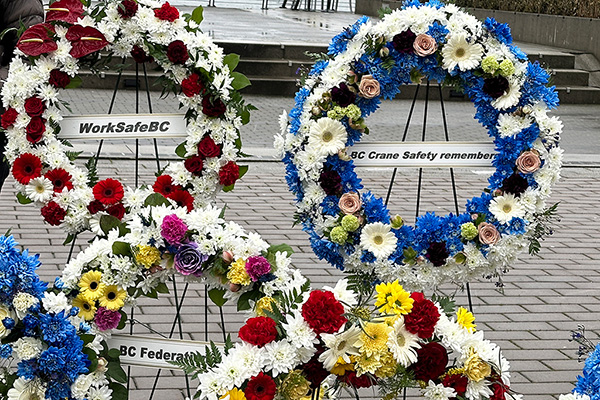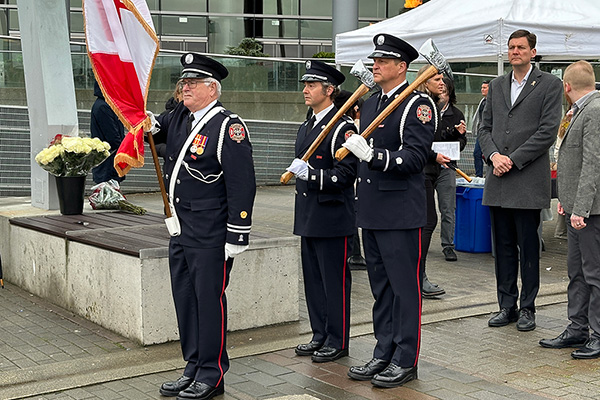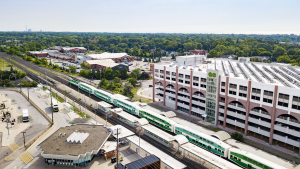Provincial politicians, labour organizations, business associations and workers all gathered at Day of Mourning events across B.C. on April 28 to pay tribute to those who died or were injured due to workplace injuries over the last year and to sound the alarm that more must be done to ensure workers go home safe after every shift.
“A lot of work has been done to try and make improvements in B.C. and there has been some progress. We celebrate that progress at the BC Federation of Labour but there’s still more work to do. The numbers speak for themselves,” president Sussanne Skidmore said.
Skidmore emphasized the importance of concentrating on and investing in prevention work to ensure workers and employers know their rights and responsibilities.

“On the other side of it, there needs to be adequate response when something does happen and people are held accountable for tragic incidents. A worker shouldn’t die at work period, but when they do and when investigations find the employer’s at fault there needs to be a consequence that actually makes sense,” she said.
Climate change a real safety concern
Skidmore also pointed to trauma after injuries and death occur and ongoing climate disasters as stressors people need to be more aware of.

1/6
WARREN FREY — Safety and labour organizations mark the deaths and injuries of B.C. workers through ceremonial wreaths at the Day of Mourning ceremony held in downtown Vancouver on April 28.
2/6
WARREN FREY — WorkSafeBC president and CEo Anne Naser spoke at the Day of Mourning ceremony in Vancouver.
3/6
WARREN FREY — Mourners move forward to lay roses at the Worker’s Memorial at Jack Poole Plaza.
4/6
WARREN FREY — The Olympic Flame in Jack Poole Plaza in downtown Vancouver is lit to mark the 2024 Day of Mourning on April 28.
5/6
WARREN FREY — A Vancouver Fire and Rescue honour guard along with B.C. Premier David Eby begins a procession before the Day of Mourning ceremony held in Vancouver.
6/6
WARREN FREY — B.C. Premier David Eby spoke to an audience of elected officials, workers, family members and stakeholders at the Day of Mourning ceremony held in downtown Vancouver on April 28.
“Over the last few years we are really seeing the impacts of climate on worker safety in the workplace, whether it’s workplaces without adequate heat or air conditioning or ventilation. And that’s not even talking about workers out on the frontline fighting fires and making sure communities are safe,” she said. “We really need to make sure we’re getting out in front of that as we head into the summer and what looks like it may be a very fraught time for forest fires and water shortages. The implications of that could be fairly traumatic for workers and we need to make sure that doesn’t happen.
“A psychological injury can happen to any worker and happens differently for every worker. Traumatic instances happen at every worksite, can happen every day and the long-term impact of psychological impact on workers is just as important as physical injury and needs to be treated as such,” Skidmore added.
Crane safety top of mind in wake of incidents
Provincial safety regulator previously announced it will emphasize inspections in 2024 as B.C.’s time-loss claims rate was 24 per cent higher in the construction sector than the provincial average for all other sectors.
WorkSafeBC prevention field services senior manager Suzana Prpic said the organization will dig deeper to see what areas should see increased focus.
“It’s part of our risk-based approach, continuing the work that we’ve been doing over the past few years to really look into our claims history and information, interview stakeholder groups and really analyze injuries and incidents…really look at those investigations in detail and determine the causal factors and corrective actions required and see where inspections need to even further target,” Prpic said.
Vancouver has also seen numerous crane collapses and related events including the death of a worker at the Oakridge development in February. Prpic said WorkSafeBC continues to consult with industry to stem further incidents.
“We had two large meetings in March and we continue to work closely with key stakeholders. I participated in a meeting where we heard about the many different areas continuing to be reviewed, including supervision for each of the phases (of crane use), detailed safe work practices and procedures for each of the phases, looking at additional engineering oversight,” she said.
She added a notice of tower crane use will mean detailed discussions are held two weeks before a crane is put up at a construction site with those who will be working onsite “to make sure everything is in place before work starts.
“We also approved the zone-limiting device last year, which really helps as workplaces are often very congested. That really helps in terms of making sure the cranes can operate safely,” Prpic said.











Recent Comments
comments for this post are closed